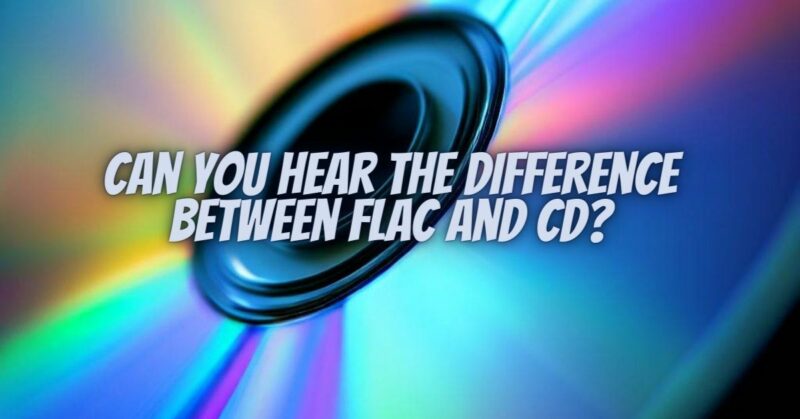The pursuit of high-quality audio is a journey filled with choices, formats, and debates. Among the many discussions in the world of audiophilia, the comparison between Free Lossless Audio Codec (FLAC) and Compact Discs (CDs) stands out. Audiophiles and music enthusiasts often ponder whether they can truly hear the difference between these two formats. In this comprehensive article, we will delve into the technical aspects, psychoacoustics, and real-world listening experiences to answer the question: Can you hear the difference between FLAC and CD?
Understanding FLAC and CD
Before diving into the comparison, let’s briefly understand the key characteristics of both FLAC and CD:
Compact Disc (CD):
- CDs use a digital audio format with a fixed set of specifications, including:
- Bit Depth: 16 bits per sample.
- Sample Rate: 44.1 kHz (44,100 samples per second).
- Compression: CDs employ Pulse Code Modulation (PCM) encoding without compression.
- CDs are widely recognized for their reliability and consistent audio quality.
Free Lossless Audio Codec (FLAC):
- FLAC is a digital audio format known for its lossless compression capabilities.
- FLAC offers flexibility in bit depth and sample rate, supporting high-resolution audio beyond CD quality.
- Lossless compression means that FLAC files can reduce file sizes without sacrificing audio quality.
Technical Differences Between FLAC and CD
- Bit Depth:
- CD: CDs use a 16-bit bit depth. This allows for a dynamic range of approximately 96 decibels (dB), which is well beyond the typical listening environment’s capabilities.
- FLAC: FLAC is capable of supporting higher bit depths, including 24-bit and 32-bit, providing the potential for even greater dynamic range and detail.
- Sample Rate:
- CD: CDs operate at a 44.1 kHz sample rate, which can accurately represent frequencies up to 22 kHz, well beyond the range of human hearing (typically up to 20 kHz).
- FLAC: FLAC offers flexibility in sample rates, accommodating higher rates that can capture frequencies beyond the CD standard. This is particularly relevant for high-resolution audio.
Psychoacoustic Factors
The human auditory system is remarkably sensitive, but there are psychoacoustic factors to consider when evaluating audio quality:
- Resolution vs. Perception: While higher bit depths and sample rates can capture more detail, human perception may not always detect these nuances. The difference between 16-bit and 24-bit audio, for example, may be subtle or even imperceptible in typical listening scenarios.
- Listening Environment: The listening environment plays a significant role. In a controlled studio environment with high-end equipment, discerning subtle differences may be easier than in a casual listening environment.
- Subjectivity: Audio perception is subjective and varies among individuals. What one person can hear, another may not, and personal preferences play a significant role in perceived audio quality.
Real-World Listening Experiences
Many audiophiles and enthusiasts have conducted listening tests to discern differences between FLAC and CD. The results often reveal a few common themes:
- High-Resolution Equipment: High-end audio equipment and studio-grade headphones or speakers are more likely to reveal subtle differences between FLAC and CD.
- Critical Listening: Engaging in critical listening, where the focus is on detailed analysis, can make it easier to detect differences. However, casual listening may not reveal significant distinctions.
- Recordings and Source Quality: The quality of the source recording has a profound impact. High-quality master recordings often showcase the benefits of higher bit depths and sample rates.
- Personal Preferences: Listeners often have individual preferences. Some may prefer the warmth and character of analog formats, while others may appreciate the precision and clarity of high-resolution digital audio.
In the quest for the ultimate audio experience, the ability to hear the difference between FLAC and CD depends on various factors, including technical specifications, psychoacoustic principles, and real-world listening conditions. While FLAC offers potential advantages in terms of bit depth and sample rate, discerning listeners with high-quality equipment may detect subtle differences, particularly in critical listening scenarios and with well-recorded source material.
Ultimately, the choice between FLAC and CD is a matter of personal preference, priorities, and the listening environment. Both formats can deliver exceptional audio quality, and the decision often comes down to individual preferences, convenience, and the desire for flexibility with high-resolution audio. Whether you can hear the difference or not, both formats offer a gateway to enjoying music in its purest form, allowing you to immerse yourself in the nuances and beauty of the music you love.


